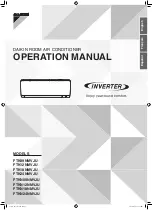
—6—
D. Installing the Indoor Unit Body to the Wall Hanging
Bracket
1. Pass the pipes through the wall sleeve and then hook
the indoor unit body on top of the wall hanging
bracket.
2. For left-hand piping, hang the unit on top of the wall
hanging bracket and incline the unit using a tool such
as a screwdriver set between the middle area of the
body and bottom right of the wall hanging bracket.
Connecting the pipe can be done more easily if the
unit is inclined.
3. Fix the bottom part of the unit to the wall hanging
bracket by pushing it carefully until the two bracket
hooks fit into the marked places at the base of the
unit until it snaps into place. Refer to Fig. 11.
NOTE:
• Do not crush or kink the indoor piping. Avoid sharp bends
with a bend radius of less than 4 inches.
• Do not over bend the same part of the pipe frequently.
• Do not remove the flare nut from the indoor unit pipe
until the piping is connected.
E. Outdoor Units
Outdoor units may be connected to indoor units using field-
supplied tubing of refrigerant grade and condition. See
Table 3 for correct line sizes. Do not use less than 10 ft of
interconnecting tubing.
If either refrigerant tubing or indoor coil is exposed to the
atmosphere, the system must be evacuated following good
refrigeration practices.
Run refrigerant tubes as directly as possible, avoiding
unnecessary turns and bends. Suspend refrigerant tubes so
they do not damage insulation on vapor tube and do not
transmit vibration to structure. Also, when passing refriger-
ant tubes through a wall, seal the opening so that vibration
is not transmitted to structure. Leave some slack in refriger-
ant tubes between structure and outdoor unit to absorb
vibration.
CAUTION:
DO NOT BURY MORE THAN 36 IN.
OF REFRIGERANT PIPE IN THE GROUND. If any
section of pipe is buried, there must be a 6-in. vertical
rise to the valve connections on the outdoor unit. If
more than the recommended length is buried, refriger-
ant may migrate to cooler, buried section during
extended periods of system shutdown. This causes
refrigerant slugging and could possibly damage the
compressor at start-up.
Indoor side
Outdoor side
1/4 to 1/2 in. lower
Drill at Slope
Drain Hose
Drain Cap
Fig. 7 — Placement of Connection Piping
Fig. 8 — Location of Drain Hose and Cap
Fig. 9 — Location of Piping
2
3
2
3
Fig. 10 — Location of Piping, Hose and Wiring
Содержание 619ENF
Страница 9: ... 9 Fig 16 619ENF01824 Matched with 538ENF Typical Wiring Schematic ...
Страница 10: ... 10 Fig 17 619ENQ018 024 Matched with 538QNF Typical Wiring Schematic ...
Страница 11: ... 11 Fig 18 619ENF030 036 Matched with 538ENF Typical Wiring Schematic ...
Страница 12: ... 12 Fig 19 619ENQ030 036 Matched with 538QNF Typical Wiring Schematic ...
Страница 16: ...Copyright 2006 Bryant Heating Cooling Systems Printed in U S A CATALOG NO 02 619E0001 SI ...


































